 Fraunhofer FEP (The Fraunhofer Institute for Organic Electronics, Electron Beam and Plasma Technology) is a research institute that focuses on innovative solutions in the fields of vacuum coating, surface treatment and organic semicconductors. The core competences technologies for the organic electronics and IC/system design are electron beam technology, sputtering, plasma-activated deposition and high-rate PECVD. The Fraunhofer FEP offers a wide range of possibilities for research, development and pilot production.
Fraunhofer FEP (The Fraunhofer Institute for Organic Electronics, Electron Beam and Plasma Technology) is a research institute that focuses on innovative solutions in the fields of vacuum coating, surface treatment and organic semicconductors. The core competences technologies for the organic electronics and IC/system design are electron beam technology, sputtering, plasma-activated deposition and high-rate PECVD. The Fraunhofer FEP offers a wide range of possibilities for research, development and pilot production.
In 2009, the Fraunhofer IPMS launched COMEDD (the Center for Organics, Materials and Electronic Devices Dresden), as a venue to develop OLED lighting and OLED microdisplay technologies. COMEDD started as a department at IPMS, then turned into an independent Fraunhofer Institute in 2012, and later it was incorporated into the FEP. In 2024 COMEDD, which now focuses on OLED microdisplays, was moved back into the Fraunhofer IPMS.
Maria-Reiche-Str. 2
01109 Dresden
Germany
Von Ardenne and the Fraunhofer FEP to intensify their cooperation on flexible glass coating
Von Ardenne announced that the company developed an innovative machine to process flexible glass. The FOSA LABX 330 Glass enables a roll-to-roll glass coating process. This first of its kind machine was developed as part of the German KONFECT project, launched in 2015, together with partners Fraunhofer FEP, Schott and Tesa.
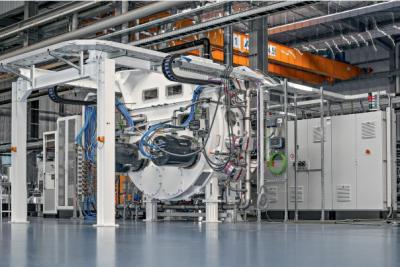
Von Ardenne now says that it intends to intensify its cooperation with the Fraunhofer FEP in the flexible glass coating field. The Fraunhofer will present coating samples of glass produced using the new machine for the first time at LOPEC 2017.
The EU launches a project to develop a 1-inch WUXGA flexible OLED microdisplay
Update: The LOMID project was actually launched in 2015, the post below details its interim results...
The EU launched a new project called LOMID (Large cost-effective OLED microdisplays and their applications) that aims to develop next-generation large-area OLED microdisplays for VR and AR applications. The project's partners will produce flexible OLED microdisplays sized 13 x 21 mm (about 1-inch diagonal) with a resolution of 1200x1920 (2,300 PPI).
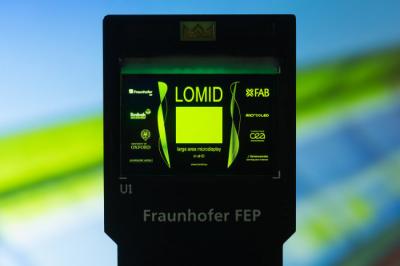
The project is led by the Fraunhofer FEP and other partners include MicroOLED, CEA-Leti and the University of Leipzig and the University of Oxford. The project will run until 31.12.2017. The Fraunhofer will demonstrate the prototype you see above at the SID-Mid-Europe Chapter Spring Meeting.
EU researchers demonstrate a flexible 2 x 1 cm OLED lighting panel with graphene electrodes
The European GLADIATOR project, led by the Fraunhofer Institute, developed a functional flexible OLED lighting panel based on graphene electrodes. This new panel is 2 x 1 cm in size - much larger the previous prototype developed as part of that project last year.
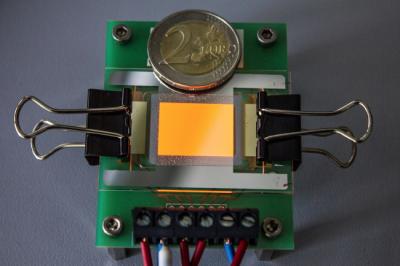
The GLADIATOR project will conclude in April 2017. In the following months, the researchers aim to improve the graphene electrode by minimizing the impurities and defects that occur during the transfer of the graphene sheet. The project's leader, Beatrice Beyer, estimate that such OLEDs with graphene electrodes could be commercialization within 2-3 years. In September 2015 Graphene-Info posted an interview with Beatrice, discussing the technology behind this project.
The Fraunhofer FEP demonstrate the first PI-SCALE flexible OLED prototypes
In March 2016 the EU launched a new project, called, PI-SCALE, that aims to create a European-wide pilot line which will enable companies of all sizes to quickly and cost effectively test and scale up their flexible OLED lighting concepts and turn them into market ready products.
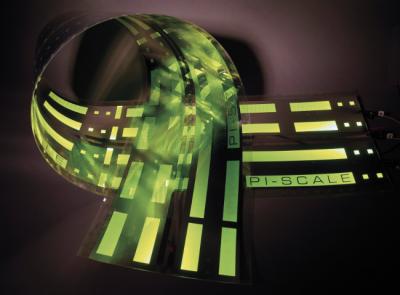
As one of the core-founders in this project, the Fraunhofer FEP is soon set to present the first demonstrators of flexible OLED out from this project. The OLED prototype you see above was deposited using a roll-to-roll by Nippon Electric Glass, on an ultra-thin glass.
The Fraunhofer FEP developed an ultra-low power OLED microdisplay
Researchers from the Fraunhofer FEP announced a new development that can reduce the power consumption of OLED microdisplays. The power reduction is enabled by new chip and control electronics, that now only handles pixel changes and does not refresh the entire display all at once.
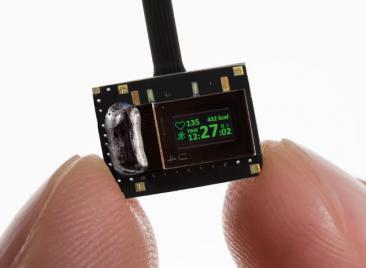
The researchers say that this development enabled a drastic reduction in power consumption - which is somewhat surprising. The new microdisplays (which are monochrome - green) use 1 to 4 mW, which they say is a fraction of the power consumed by the Fraunhofer's previous generation display - a color (WOLED+CF) bi-directional OLED (so this is not a fair comparison of course).
The Fraunhofer FEP now offers development kits based on bi-directional OLED microdisplays
In March 2015 the Fraunhofer FEP demonstrated its second-generation bi-directional OLED microdisplays, with a resolution of 800x600 (SVGA), up from VGA in the first generation first unveiled in 2012.
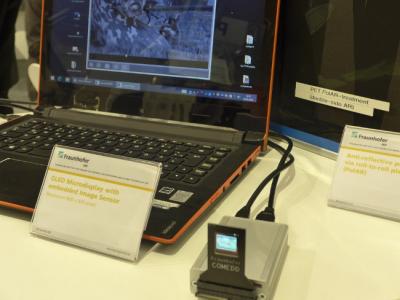
The Fraunhofer is now making a new development platform of these bi-directional eyeglasses, based on the new microdisplays, available to clients creating proprietary products. The updated platform has a new hardware design with standard HDMI and USB interfaces. The new eyeglasses were developed as part of the FAIR project, funded by the German Federal Ministry of Education and Research (BMBF).
Fraunhofer researchers find that flexible OLEDs are safe for light treatment
The Fraunhofer Institute is working on alternative light sources for photo therapy, and Flexible OLED technology is prime candidate because it is light weight, can be flexed and does not produce almost any heat (unlike LED-based lighting).
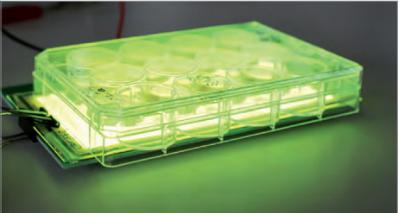
Before flexible OLEDs are actually used in such treatment, though, it is important to know if OLEDs carry any potential toxic risks. The Fraunhofer FEP performed an initial study on in vitro cell cultures afflicted by defined damage. The researchers used flexible 10x10 cm green OLEDs, and found that the OLEDs positively stimulated the damaged cells, as expected. The tests showed now cytotoxity in the material systems, including when the OLEDs were bent (this increases the chance of material leakage from the OLEDs).
The Fraunhofer FEP launches a flexible electronics-healthcare idea competition
The Fraunhofer FEP, as part of its flex+ project, launched a new idea competition called flexMED. Fraunhofer is aiming to collect ideas for applications that combine flexible electronics and medicine and healthcare.
You can submit your ideas until July 31st, and the three winner will receive €3,000 in total. The Fraunhofer team says that they are looking for innovative ideas that leverage diverse possibilities of flexible electronics. They would especially value ideas that contribute to well-being, recovery and cure of patients.
The German R2D2 flexible OLED project was successfully completed
In October 2013, the German Federal Ministry of Education and Research (BMBF) launched a new flexible OLED lighting project called R2D2 with an aim to investigate new production technologies, including roll-to-roll techniques.
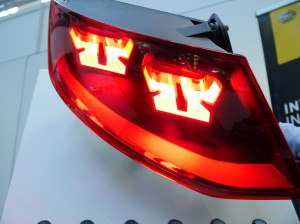
R2D2's coordinator Fraunhofer FEP, now reports that the project has been successfully completed. OLED production processes and market sectors were thoroughly analyzed, the potential for improvement was identified and realized. The project partners developed a series of OLED lighting applications combining special design features with efficient fabrication techniques.
The Fraunhofer FEP developed a glass-on-glass lamination process for flexible OLED production
The Fraunhofer FEP announced new large-area flexible OLED lighting panel prototypes that have been fabricated on ultra-thin glass and encapsulated with a ultra-thin glass foil in the same process.
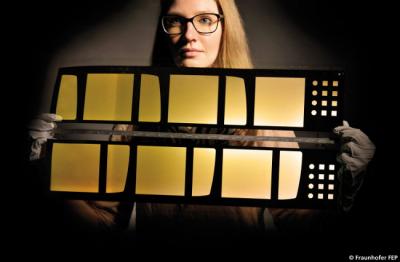
The new process developed at the Fraunhofer institute is able to deposit OLEDs on the flexible glass and encapsulation it using an additional flexible glass layer - all in a a single roll-to-roll manufacturing step.
Pagination
- Previous page
- Page 4
- Next page



